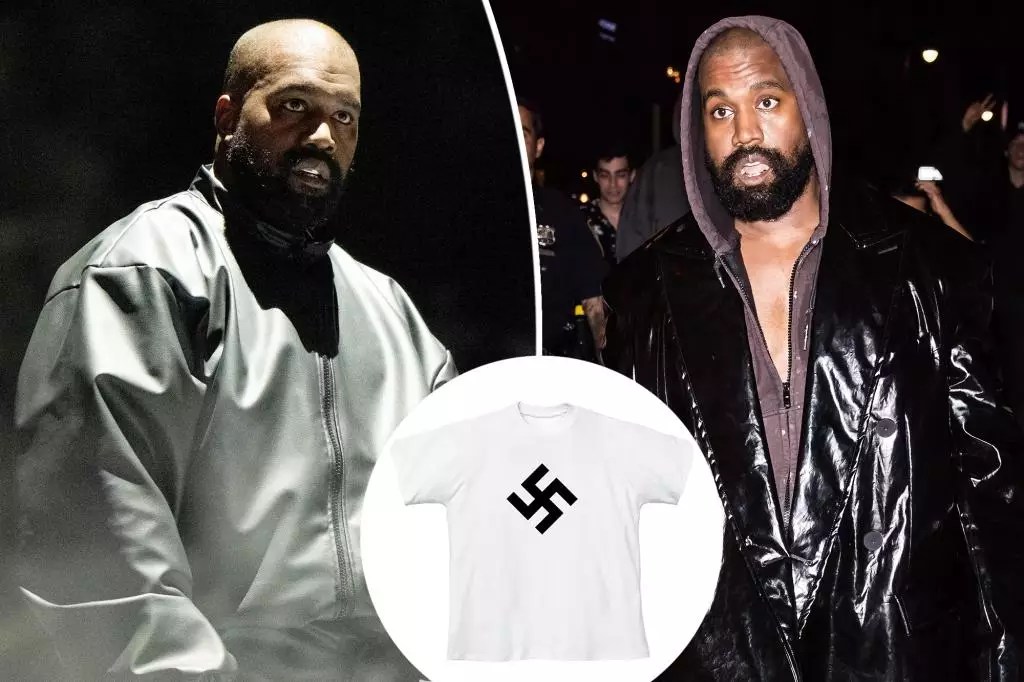Kanye West, now legally known as Ye, once again thrust himself into the spotlight with a polarizing Super Bowl advertisement. Airing during one of the most-watched events in American sports, the ad, promoting his Yeezy apparel line, featured a T-shirt design that has sparked outrage across various communities. The shirt, which retails for $20 and bears a Swastika, is being sold under the name “HH-01,” a moniker identified by the Anti-Defamation League (ADL) as a coded reference to a notorious phrase. Such a display was not just a marketing tactic but a grave symbol of hate.
It is crucial to assess the marketing strategies employed by public figures in the current climate of heightened awareness of social issues. Ye’s decision to endorse a T-shirt with a Swastika during a prominent cultural event raises significant ethical questions. The advertisement allegedly aired only in selective markets—Los Angeles, Philadelphia, and Atlanta—indicating a strategic but dubious approach to publicity. By restricting its reach, Ye might have aimed to invoke curiosity and controversy without facing the immediate backlash on a national scale. Critics, however, have argued that such tactics are irresponsible and dangerous, effectively normalizing hate symbols in mainstream culture.
Ye himself boasted about the production of the ad, casually mentioning that he filmed it on an iPhone after spending his commercial budget on dental grills. This flippant attitude toward the severity of the symbol he is promoting exemplifies a troubling trend. Does the pursuit of artistic expression and self-promotion excuse an individual from accountability when their actions cause tangible harm to marginalized communities? The answer should lean towards a definitive no, yet Ye’s ongoing provocations complicate this narrative.
The ADL was swift to condemn Ye’s actions, branding his choice of marketing a single T-shirt with such a notorious symbol as blatant antisemitism. Their statement emphasized the historical context of the swastika as a focal point of Nazi propaganda, recognizing its lasting impact on communities targeted by such ideologies. The organization noted the hypocrisy in his behavior, calling out the amplification of hate speech via a platform as influential as a Super Bowl ad. This serves as a wake-up call for consumers and the public alike, highlighting the responsibilities of celebrities and corporations in curbing hate speech.
In our interconnected world, the ramifications of one’s actions can reverberate across borders, influencing opinions, identities, and even inciting violence. Ye’s remarks that express love for Adolf Hitler and proclaim a sense of identification with Nazi ideology transcend artistic freedom, breaching the boundaries of acceptable discourse.
Ye’s assertion that the T-shirt is his “greatest performance art piece” introduces another layer to this discussion: the intersection of personal responsibility and the quest for artistic expression. While many artists utilize provocative imagery to challenge norms or provoke thought, the line becomes blurred when such expressions incite hatred and division. Ye’s previous attempts at apologies for similar remarks did little to quell rising concerns; rather, they raised questions about his understanding of the implications of his words and actions.
Scrutiny of his statements on social platforms further illustrates a deeply concerning pattern. His declarations of supremacy, combined with disparaging comments aimed at individuals who challenge his viewpoints, only further sidetrack meaningful dialogue concerning race and privilege. Rather than engaging in discussions about identity and community, Ye appears persistently fixated on self-glorification and victimhood.
As we reflect on this episode, we must consider its implications for societal discourse. Ye’s Super Bowl ad and the symbolic content it showcases do not exist in a vacuum; they contribute to an environment where hate speech can flourish under the guise of artistic expression. The potential normalization of such rhetoric serves as a clarion call for vigilance against antisemitism and racism in all forms.
In closing, Kanye West’s recent actions are not just a personal branding misstep; they challenge us as a society to grapple with the question of where we draw the line between artistic freedom and the promotion of hateful ideologies. Conversations around intentionality, context, and consequence must take center stage if we are to navigate the complexities of modern discourse. Ultimately, the urgency of confronting hate symbols and ideologies becomes an undeniable responsibility we all share.


Leave a Reply